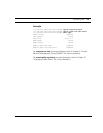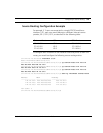
Cuda 12000 IP Access Switch CLI-based Administration Guide
Configuring IP Source Routing 321
About IP Source Routing
Source routing allows you to configure a different default route for each IP
network or host. Specifically, source routing allows you to define the default
route (next hop gateway) to which a packet containing a particular source IP
address should be forwarded in the event that a local route to the
destination does not exist. This feature is called source routing because the
route is determined by the source of the message.
When an IP packet is received on an interface:
■ The interface performs a normal destination-based route lookup.
■ If the system finds no route, or if a default route exists for the destination
IP address, it then checks the source routing entries defined on the
interface.
■ If the system finds a source routing entry defined for the source address,
the packet is forwarded to the next hop gateway associated with the
source address. Otherwise, the default route defined in the routing table
is used.
This logic enables local routes to take precedence over both default routes
and source routing entries; but enables source routing entries to take
precedence over default routes. This allows local servers, such as mail
servers, provisioning servers, and web caching servers to be used first. But if
no local routes exist, you can define the next hop gateway based on the
source address of the host.
Source routing is configured on an interface using the
ip source-route
command. This command allows you to define the following source routing
criteria:
■ Source IP address to match: An IP address and network mask
combination allows you to define the source route to match as a
network, or scope it down to a specific host.
■ Next Hop Gateway: The IP address to which the system must forward
any matching IP datagrams. Note that you must enter a valid next hop
destination.


















